Best Intercom Alternatives for SaaS

Exploring alternatives to Intercom? With plenty of choices available, it’s difficult to decide which one will be the right fit.
The crux of the issue is – to make the right choice, you need to account for your priorities: your different jobs to be done, your budget, and the size of the company. But don’t worry – we’re coming to help!
In this post, we’ll discuss exactly that – which Intercom competitor is best depending on the different use cases.
Let’s dive in!
TL;DR
- Intercom is a customer service platform. It offers customizable live chat widgets, omnichannel support capabilities, and integrations with over 300 apps. While Intercom is primarily a support solution, it does have add-ons that offer other functionalities such as product tours.
- The Product Tours add-on contains features that aid onboarding, adoption, and feature discovery. Intercom’s product tours can include UI patterns like modals and tooltips as well as other media formats such as microvideos.
- While Intercom is a flexible and popular solution when it comes to customer service, there are certain use cases where it will likely fall short compared to other options.If you’re in any of these scenarios, you should look for an alternative platform for your needs:
- Onboarding and Adoption: If onboarding new users and driving product adoption are your primary use cases then Intercom may not be the best choice. Its Product Tours add-on is quite limited compared to dedicated adoption platforms (and costs almost as much).
- Budget Constraints: Early-stage SaaS companies with a limited budget should be wary of Intercom’s pricing model. Its entry-level plan starts at an affordable $74/month but getting the Product Tours add-on and extra team seats could lead to your subscription cost skyrocketing.
- Mobile Apps: While Intercom’s core features, like the live chat messenger work on mobile apps, its product tours add-on is only compatible with desktop platforms.
- Here are the top Intercom alternatives you can consider:
- Userpilot is a product growth platform that drives user activation, feature adoption, and expansion revenue. It also helps product teams collect user feedback, streamline onboarding, and gather actionable insights from analytics. With Userpilot, you’ll be able to track both product usage and user behavior to get a holistic view of how customers use your product — which will guide future development, improve the user experience, and inform your growth efforts.
- HelpHero is a tool that enables businesses to build interactive, easy-to-follow product tours that help engage users from day one and speed up feature adoption quicker than ever. In addition, with HelpHero, you can easily create and customize walkthroughs without coding. You can use it to ensure users know what’s new and how to use it. The result – is less frustration and confusion and higher user adoption and retention.
- Help Scout is a help desk software solution designed to help businesses provide seamless customer support. The platform offers a broad spectrum of features, including shared inbox, live chat, and knowledge base, to manage and organize customer support interactions. Help Scout lets you assign customer conversations to specific team members and resolve urgent requests on priority. You can even set up workflows to automate routine tasks and speed up response times. Additionally, the live chat feature lets you communicate with customers in real time and provide immediate assistance. You also have the option to collect user feedback through microsurveys and NPS (Net Promoter Score) surveys.
- Whatfix is a digital adoption platform that helps enterprise organizations with onboarding, training, and supporting their employees or customers. It accomplishes this through in-app guidance and messaging to provide on-demand support whenever it’s needed. The solution also lets you track analytics on all in-app guidance, collect user feedback, build out self-serve content, and automate certain flows. Whatfix even has integrations with Salesforce, Amplitude, Google Analytics, Slack, Confluence, and other platforms to maximize collaboration.
- Interested in driving product growth without coding? Book a demo to see how we can help!
What is Intercom?
Intercom is a customer service platform. It offers customizable live chat widgets, omnichannel support capabilities, and integrations with over 300 apps. While Intercom is primarily a support solution, it does have add-ons that offer other functionalities such as product tours.
The Product Tours add-on contains features that aid onboarding, adoption, and feature discovery. Intercom’s product tours can include UI patterns like modals and tooltips as well as other media formats such as microvideos.
What are the main use cases for Intercom?
Understanding the core functionalities and use cases of Intercom is crucial for deciding whether or not it’s the right choice for you.
Without further ado, let’s see the primary scenarios where Intercom is useful for your SaaS business!
Intercom for user onboarding
User onboarding educates new customers, teaches them how to use your product, and helps them get the most value in the least amount of time.
Intercom’s Product Tours add-on includes UI patterns and onboarding analytics that can prove helpful (if you’re willing to pay extra for them).
This will cost you an additional $199/month on top of what you’re currently paying for your base Intercom subscription. This puts its pricing on par with dedicated onboarding/adoption tools despite lacking feature parity.
Here’s an overview of Intercom’s Product Tours add-on:
- UI Patterns: Intercom’s product tours for onboarding come with an expansive selection of UI patterns like tooltips, banners, surveys, in-app checklists, and multi-step flows. You can also use communication features in your tours such as SMS messages or live chat widgets.
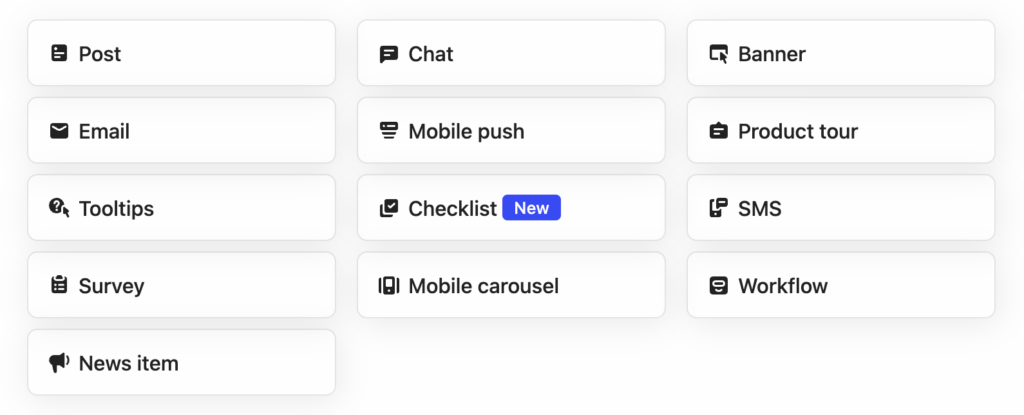
- Onboarding Analytics: Intercom shows you detailed analytics for each product tour such as the total number of views, overall completion rate, percentage of users who achieved a particular goal, and how many issues were encountered during the tour.
Intercom for product analytics
Product analytics track all data related to using the product itself so you can get a better understanding of user behavior and identify areas for improvement.
Intercom helps you monitor analytics with third-party integrations and subscription add-ons.
- Integrations: The Intercom App Store has integrations with over 300 third-party tools. These include dedicated analytics solutions like Amplitude, Heap, Databox, Google Analytics, and CRM platforms like Salesforce or HubSpot.
- Analytics (Add-On): The Analytics for Intercom add-on expands its reporting capabilities to include a segment explorer, user attributes, and retention analysis. The analytics add-on costs an additional $50/month to $200/month (on top of your current plan), depending on the tier.
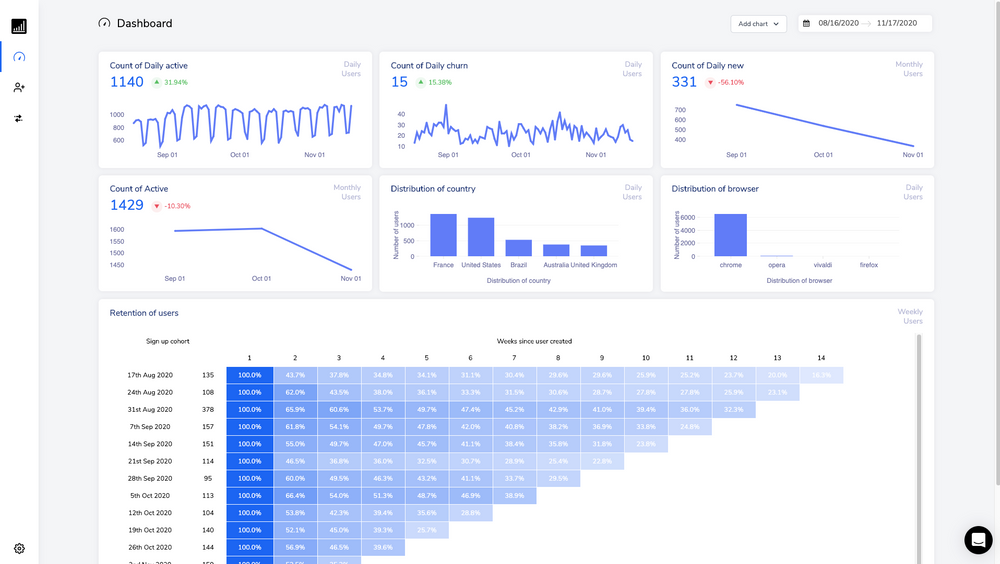
Intercom for self-service support
Self-service support helps users solve their own problems so they get faster resolution times without needing to take up the time of your support representatives. Intercom has self-service support features like a help center, chatbot, and third-party knowledge base integrations.
Here’s how you can use Intercom to create a self-service customer experience:
- Help Center: The Intercom help center lets you publish resources in multiple languages, host them on a custom domain, and embed third-party apps if needed. Any help articles published here will also be used to feed information to your support chatbots down the line.
Note: Intercom’s multilingual help centers are only available on the Pro tier and higher which means users on the entry-level Starter plan ($74/month) won’t be able to use this feature. Help articles aren’t automatically translated so you’ll need to rewrite them manually as well.
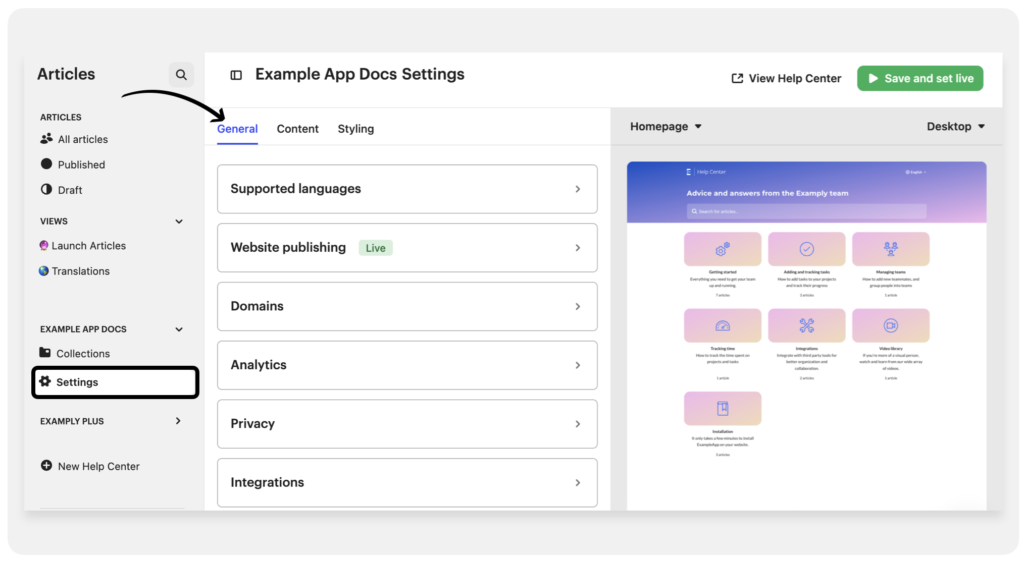
- Fin Chatbot: The Fin chatbot is built on GPT-4 which allows it to respond naturally while drawing data from multiple sources. It can reference articles in your help center, look at conversation data, search through public URLs, or pull information from integrations.
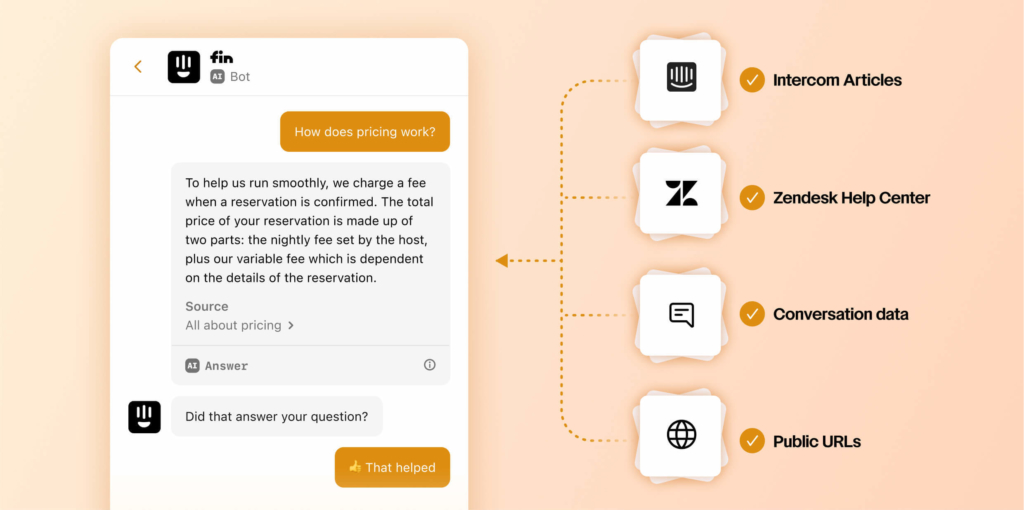
- Third-Party Integrations: Intercom has integrations for external knowledge base solutions. There are over 20 knowledge base tools that Intercom can integrate with to import articles, videos, and other support data. This includes Zendesk, Freshdesk, HelpDocs, and more if you are on the Pro plan (the Starter plan drastically restricts available integrations).
What are the pros and cons of Intercom?
Pros of Intercom?
- Robust Live Chat: Intercom’s live chat widget is the most popular feature on the platform. You’ll be able to style the widget in accordance with your brand colors, choose which support options customers will see, and insert apps to create a self-serve experience.
- Product Tours Add-On: In addition to Intercom’s customer service capabilities, its Product Tours add-on offers support to new users during the onboarding and adoption phases. Features include a no-code builder, audience targeting, analytics reporting, and more.
- Extensive Integration Gallery: If Intercom’s built-in support/onboarding features aren’t enough, you can expand its native functionality using third-party integrations. Intercom’s App Store has over 300 tools to choose from with new solutions being added regularly.
Cons of Intercom?
- Buggy Search Function: Searching through support tickets is a core task for Intercom users but this process is often laggy or refuses to work altogether by freezing the page. Intercom’s searchability shortcomings have been present for years with no fixes released.
- Confusing Navigation Interface: While Intercom does have a wide array of features, its user interface isn’t intuitive and it’ll take a lot of memorization (or trial-and-error) to figure out where everything is. There are many features that can (and should) be combined into one page.
- Support Response Times: Intercom is a customer service platform which is why it’s ironic that their support team isn’t able to reliably respond in a timely manner. Numerous customers have noted slow response times from support representatives when reviewing Intercom.
What do users say about Intercom?
Intercom users were impressed with the interaction features such as emojis, GIFs, and avatars:
“I really like the fact that you can send emojis, have an avatar, interact with the client and know what their tastes are as such, it is very interactive to the point that you can jump between chats recognizing each of the clients/agents.”
 Of course, other customers were upset by the lack of transparent billing, inadequate support experience, constant upsells, and restrictive feature limitations:
Of course, other customers were upset by the lack of transparent billing, inadequate support experience, constant upsells, and restrictive feature limitations:
“Purposely opaque and dishonest billing systems.
Incompetent staff.
Once you have it installed they exploit you for CONSTANT fee hikes.
Constant pitches to upgrade plans and required extra fees.
Unnecessary limitations on features”

Does Intercom fit your budget?
Intercom’s plans start at $74/month on the entry-level plan and use custom pricing for the Pro tier or higher. There’s no free version available, but Intercom does offer a 14-day free trial that lets you test all features on the Starter tier before upgrading to a paid subscription.
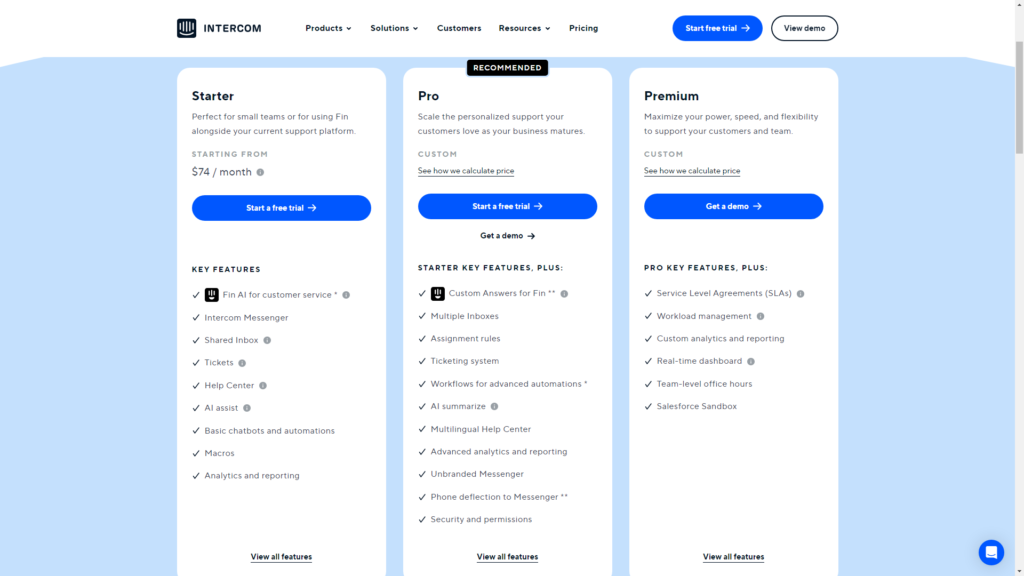
Intercom has three paid plans to choose from and different add-ons priced separately:
- Starter: Starts at $74/month and includes two team seats, and features like the messenger widget, automated chatbots, shared inbox, real-time tickets, help center, macros, and basic analytics reporting capabilities.
- Pro: Custom pricing based on the number of team seats and MAUs. It includes features like multiple inboxes, assignment rules, ticketing systems, localized help centers, and advanced automation/analytics.
- Premium: Custom pricing based on the number of team seats and MAUs. It includes features like a real-time dashboard, custom analytics, workload management, and a service level agreement.
In addition to the base subscription cost, you’ll need to pay an additional $199/month if you want to use the Product Tours add-on. This means that, even on the Starter plan, you’d still be paying almost $300/month in total if you get the Product Tours add-on to go with it.
3 Reasons why you might need an Intercom alternative
While Intercom is a flexible and popular solution when it comes to customer service, there are certain use cases where it will likely fall short compared to other options.
If you’re in any of these scenarios, you should look for an alternative platform for your needs:
- Onboarding and Adoption: If onboarding new users and driving product adoption are your primary use cases then Intercom may not be the best choice. Its Product Tours add-on is quite limited compared to dedicated adoption platforms (and costs almost as much).
- Budget Constraints: Early-stage SaaS companies with a limited budget should be wary of Intercom’s pricing model. Its entry-level plan starts at an affordable $74/month but getting the Product Tours add-on and extra team seats could lead to your subscription cost skyrocketing.
- Mobile Apps: While Intercom’s core features like the live chat messenger work on mobile apps, its product tours add-on is only compatible with desktop platforms.
Better alternatives to Intercom
Considering alternative options to Intercom can often lead to discovering more tailored solutions that better suit your needs. Here are the top Intercom alternatives you can consider:
- Userpilot is a product growth platform that drives user activation, feature adoption, and expansion revenue. It also helps product teams collect user feedback, streamline onboarding, and gather actionable insights from analytics. With Userpilot, you’ll be able to track both product usage and user behavior to get a holistic view of how customers use your product — which will guide future development, improve the user experience, and inform your growth efforts.
- HelpHero is a tool that enables businesses to build interactive, easy-to-follow product tours that help engage users from day one and speed up feature adoption quicker than ever. In addition, with HelpHero, you can easily create and customize walkthroughs without coding. You can use it to ensure users know what’s new and how to use it. The result – is less frustration and confusion and higher user adoption and retention.
- Help Scout is a help desk software solution designed to help businesses provide seamless customer support. The platform offers a broad spectrum of features, including shared inbox, live chat, and knowledge base, to manage and organize customer support interactions. Help Scout lets you assign customer conversations to specific team members and resolve urgent requests on priority. You can even set up workflows to automate routine tasks and speed up response times. Additionally, the live chat feature lets you communicate with customers in real time and provide immediate assistance. You also have the option to collect user feedback through microsurveys and NPS (Net Promoter Score) surveys.
- Whatfix is a digital adoption platform that helps enterprise organizations with onboarding, training, and supporting their employees or customers. It accomplishes this through in-app guidance and messaging to provide on-demand support whenever it’s needed. The solution also lets you track analytics on all in-app guidance, collect user feedback, build out self-serve content, and automate certain flows. Whatfix even has integrations with Salesforce, Amplitude, Google Analytics, Slack, Confluence, and other platforms to maximize collaboration.
Let’s see the features and functionalities of these tools for different use cases!
Intercom vs Userpilot
There are many ways how Userpilot is different (and in a lot of ways better!) from Intercom. Let’s explore the features of Userpilot, how it’s better than Intercom, and how it may fall short too.
Userpilot for user onboarding
User onboarding is a crucial part of the customer journey as it speeds up the adoption process and increases retention rates. Onboarding is one of Userpilot’s core use cases along with product growth analytics and user feedback, so it has plenty of features that you can utilize.
Here are some Userpilot features you can use when onboarding new users:
- No-code builder: Creating flows with Userpilot is as simple as installing the Chrome extension, selecting the UI patterns you’d like to use, and then editing the content/settings to suit your use case. You can also use templates to create modals, slideouts, tooltips, and driven actions.

No-code flow builder in Userpilot.
- Native tooltips: Userpilot lets you create native tooltips that show up when users hover over an element or click on an information badge. Since these native tooltips attach to the element itself, they aren’t page-dependent and will show up on any screen where that element is visible.

Build native tooltips with Userpilot.
- Advanced flow settings: With advanced condition settings, you can decide when, where, and who you’ll be triggering your onboarding flows. This helps you create contextual and personalized onboarding experiences that drive engagement and adoption.
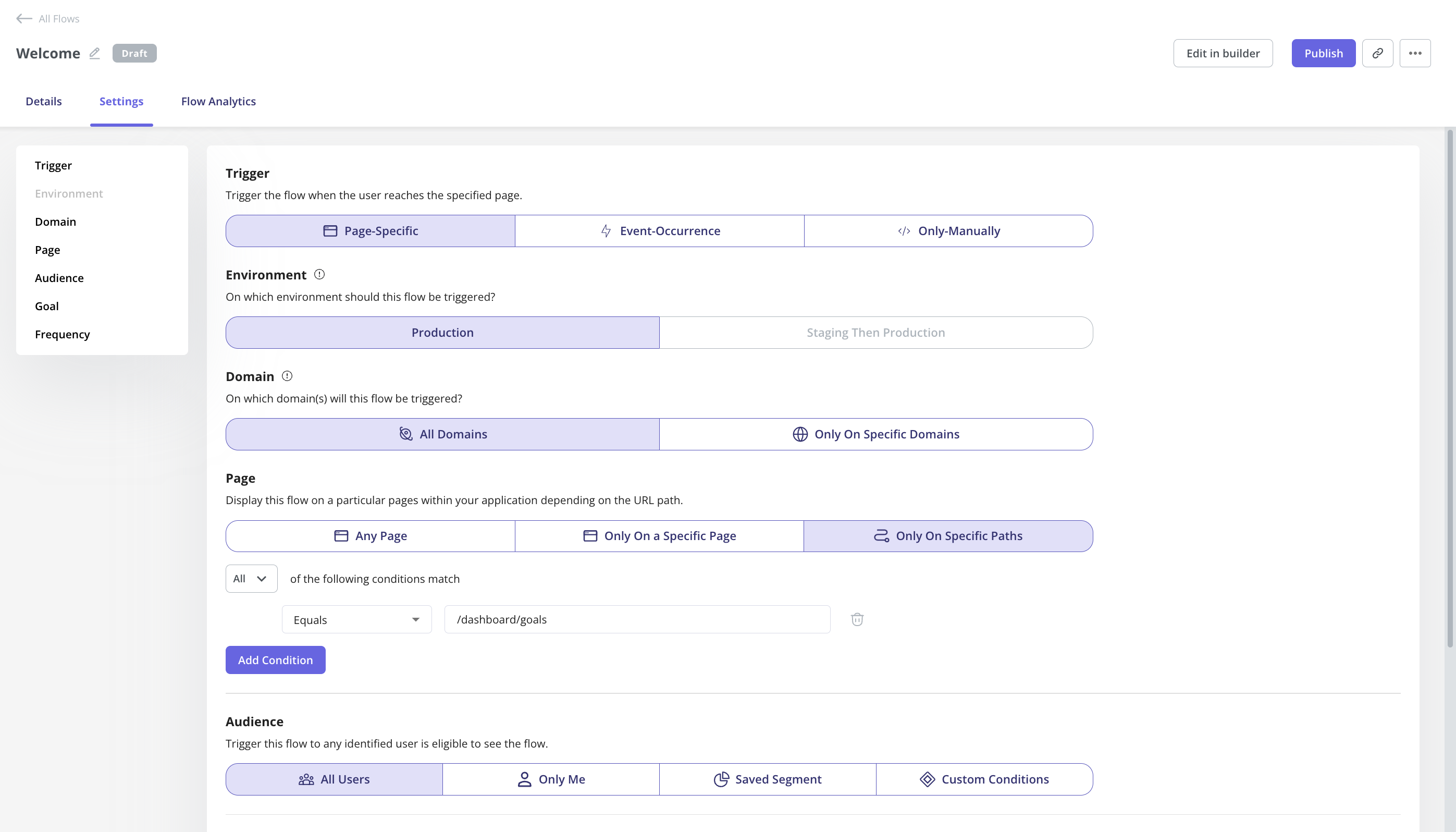
- Onboarding engagement analytics: You can easily assess the impact of your onboarding flows, guidance, etc. by analyzing the engagement rate of tooltips, interactive walkthroughs, checklists, etc. In addition, you can also build reports (funnels, paths, etc.) or dashboards to track your core onboarding metrics i.e. activation, stickiness, drop-offs, etc.
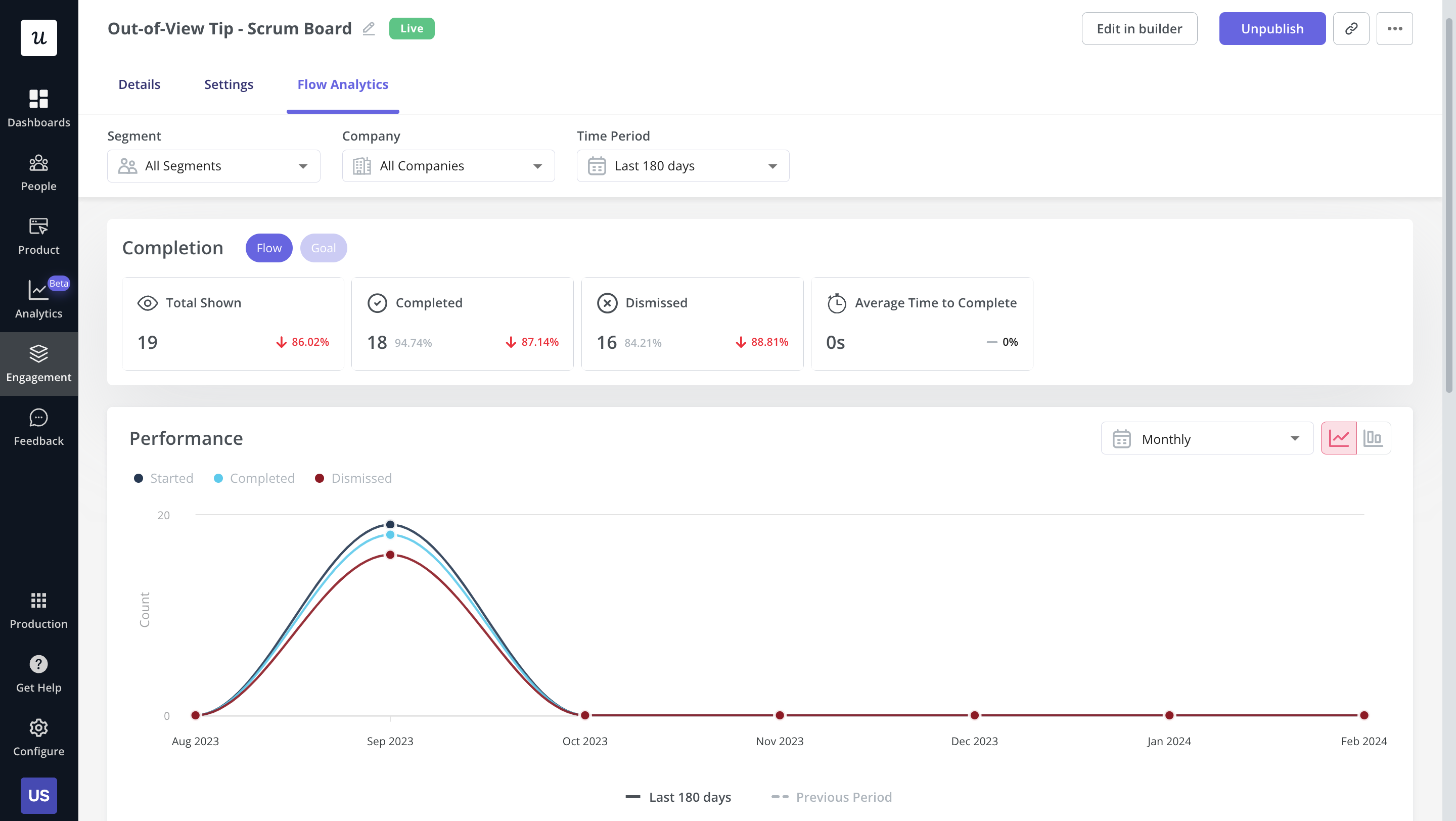
Userpilot for product analytics
Product analytics lets you collect and analyze data about how users interact with your product so you can extract actionable insights. Userpilot lets you look at granular product analytics, such as which features have the highest adoption rates, and big-picture insights like trend reports. Here are Userpilot’s top product analytics features:
- Feature tagging: Userpilot’s click-to-track feature tagger lets you view how many times a feature has been used and by how many users to measure its adoption. Users on the Starter plan can add up to 10 feature tags while those on the Growth or Enterprise tier can create unlimited tags.
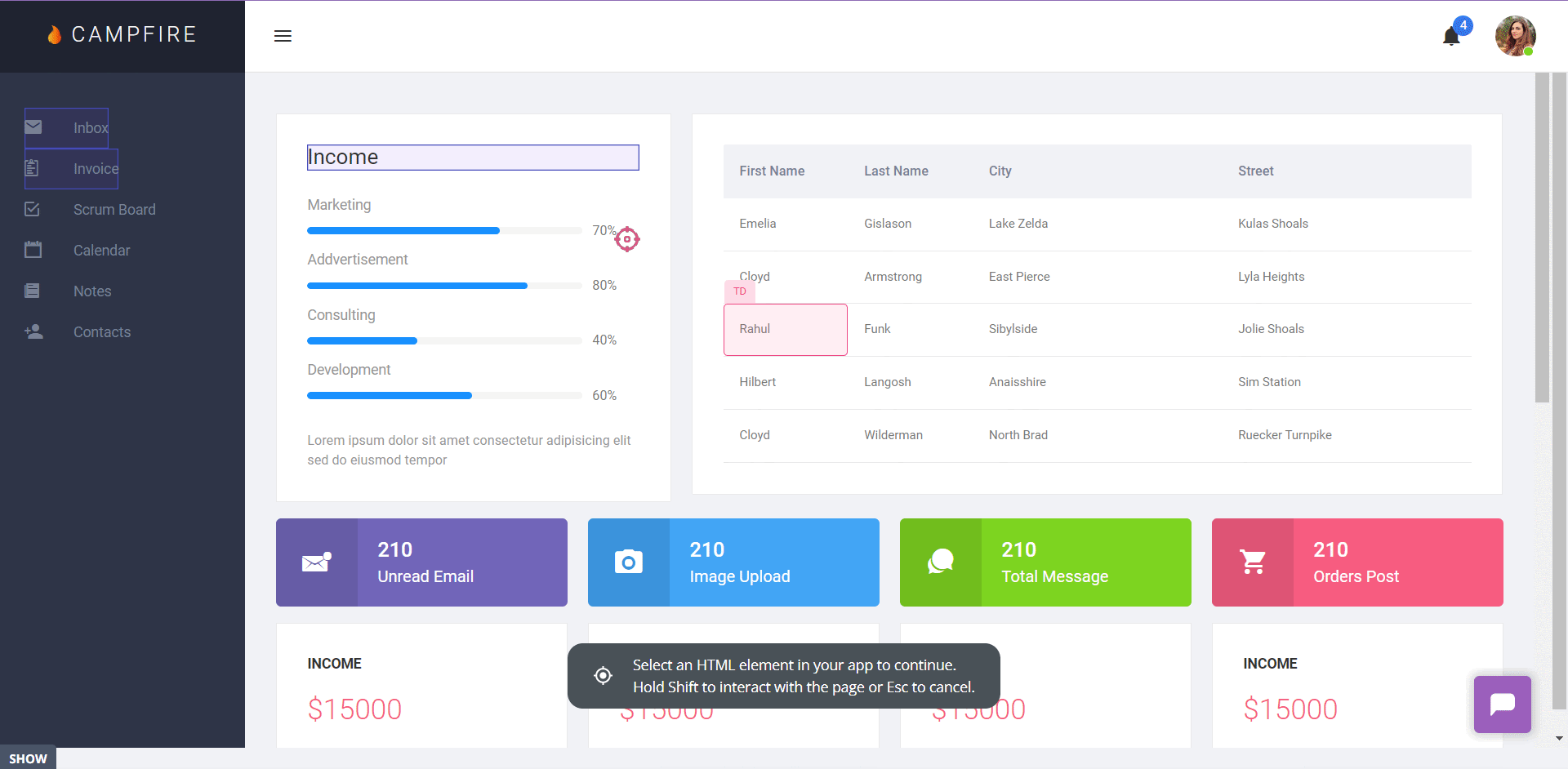
No-code feature tags in Userpilot.
- Event-tracking: Alongside no-code feature tags for feature engagement tracking, you can also track other events unique to your product using event-tracking. You can also create a group of events to track a specific process i.e. onboarding, subscription, etc.
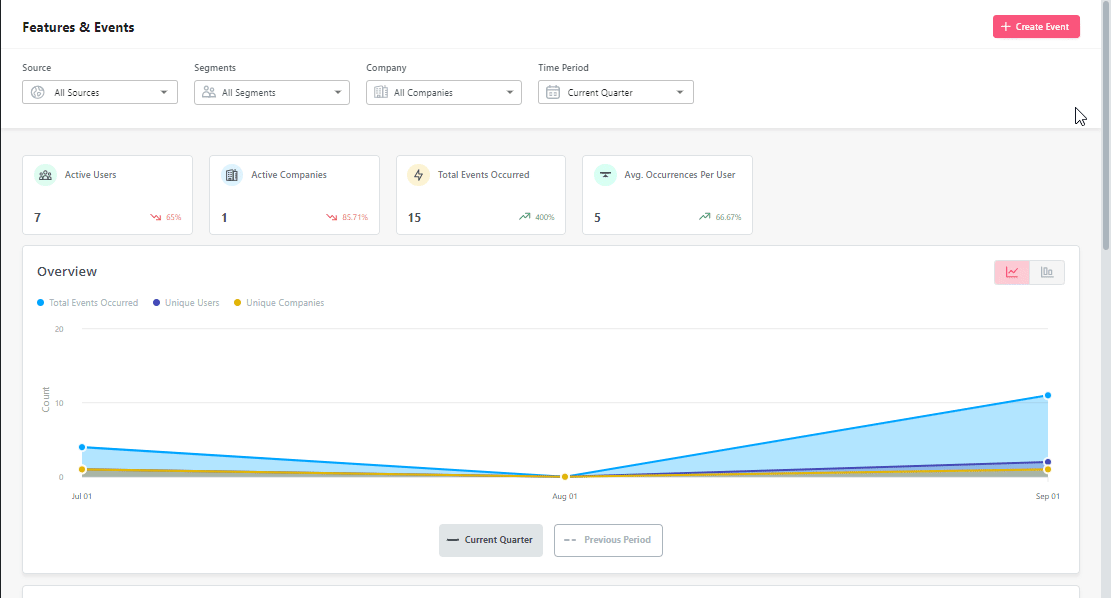
Create tracked events to monitor server-side data.
- Trends and funnels: Userpilot’s trends and funnels report lets you extract actionable insights from big data. You’ll be able to see which stage of an onboarding/conversion funnel most users drop out on and create trend reports with detailed breakdowns by user or period.
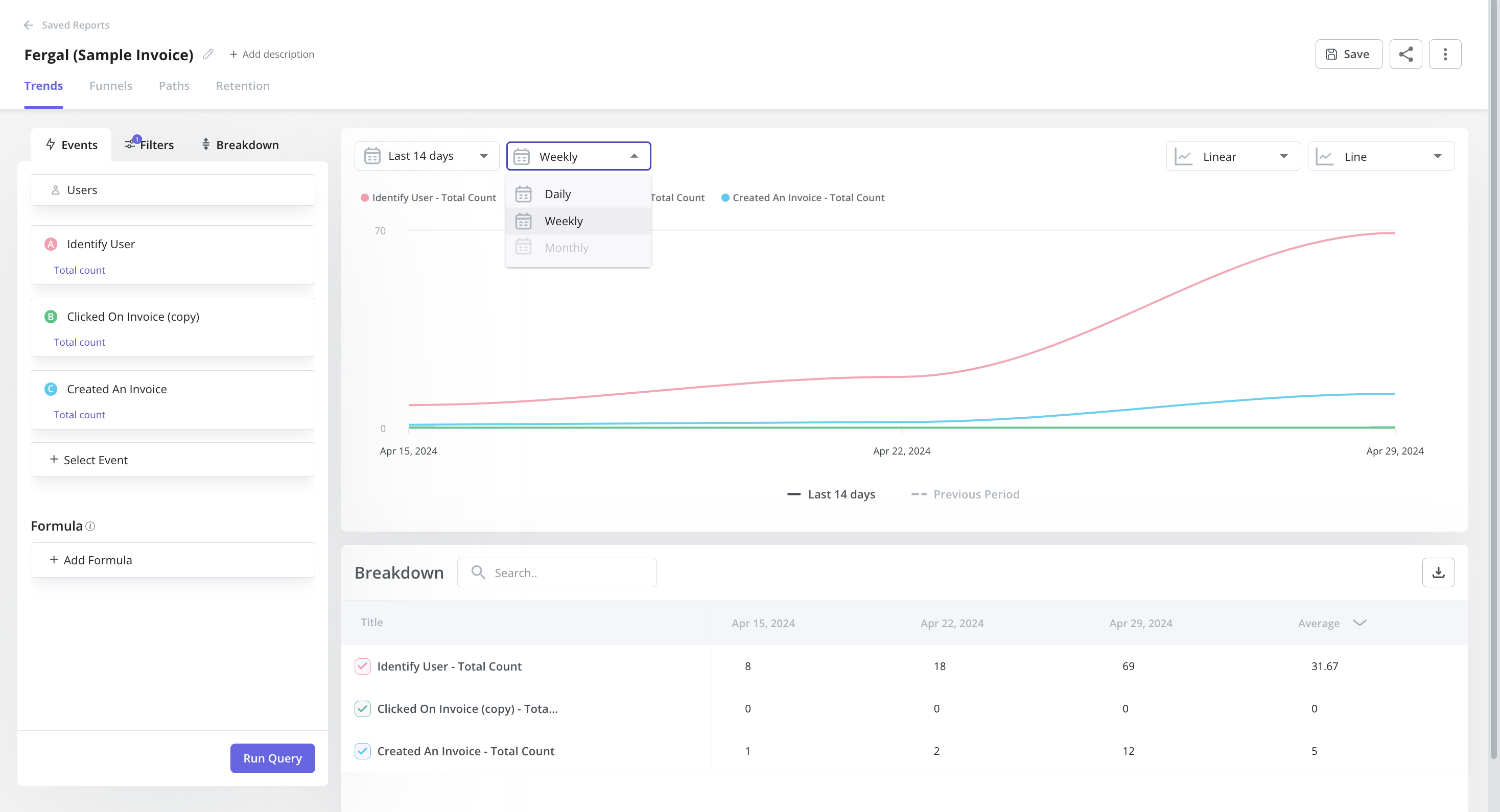
Example of a trend report in Userpilot.
- Retention tables: This lets you gauge product performance – how effective it is at retaining users using cohort tables and retention curves.
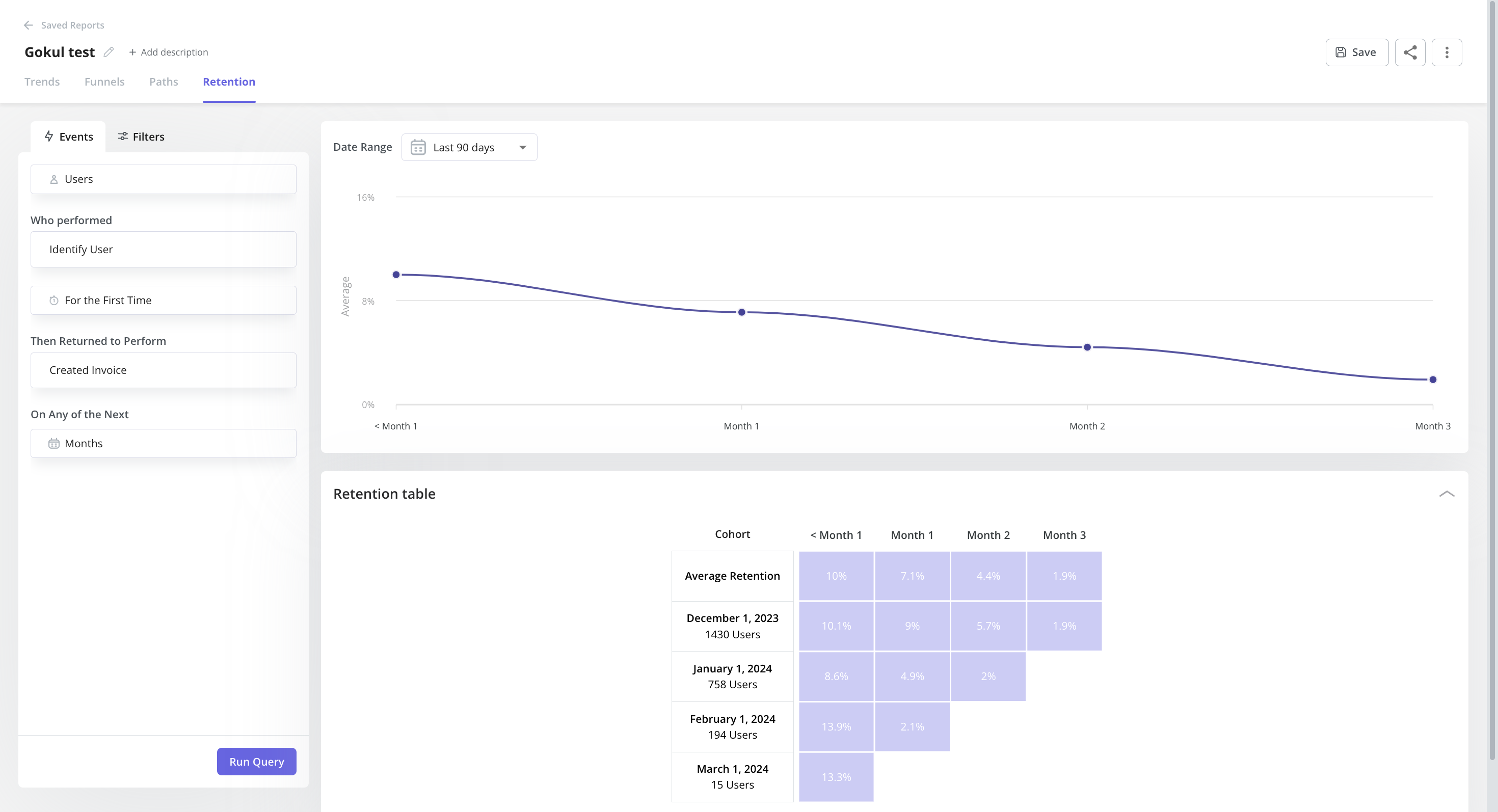
- Paths: You can generate and access path reports directly within the reporting builder in Userpilot, alongside funnels, trends, and retention reports. With Paths, you can have an overview of how users navigate your product features – offering invaluable insights into their interactions with your products.

- User & Company profiles: Here you can view data related to a certain user/company to gain insights into their behavior and improve the overall user tracking experience. This helps you understand how they engage with your product or platform, better identification of areas of improvement, and tailor their offerings more effectively.
 User profile with top event data that provides insights into what feature they regularly engage with
User profile with top event data that provides insights into what feature they regularly engage with - Analytics dashboards (Product Usage, New Users Activation, Core Feature Engagement, User Retention, etc.): These dashboards enable you to keep track of your key product performance and user behavior metrics at a glance, without any technical setup required.

- Analytics integrations: Userpilot integrates with some of the most popular analytics tools like Amplitude, Mixpanel, Segment, Google Analytics, and more. This makes it possible to sync product analytics both ways between the tools in your tech stack (two-way integration is only available for Hubspot at the time of writing, more to come).

Userpilot for self-service support
Here’s how you can use Userpilot to create a self-service customer experience:
- No-code builder: Userpilot’s no-code resource center lets you add modules without writing a single line of code. Module options include links, videos, flows, custom JavaScript functions, and checklists. You can also group modules into sections to help users navigate the resource center.

Add different types of content to your resource center.
- Module segmentation: Userpilot’s segmentation settings let you hide or show specific modules within your resource center based on audience settings. This makes it possible to create modules for different user segments and hide resources that aren’t relevant to other users.
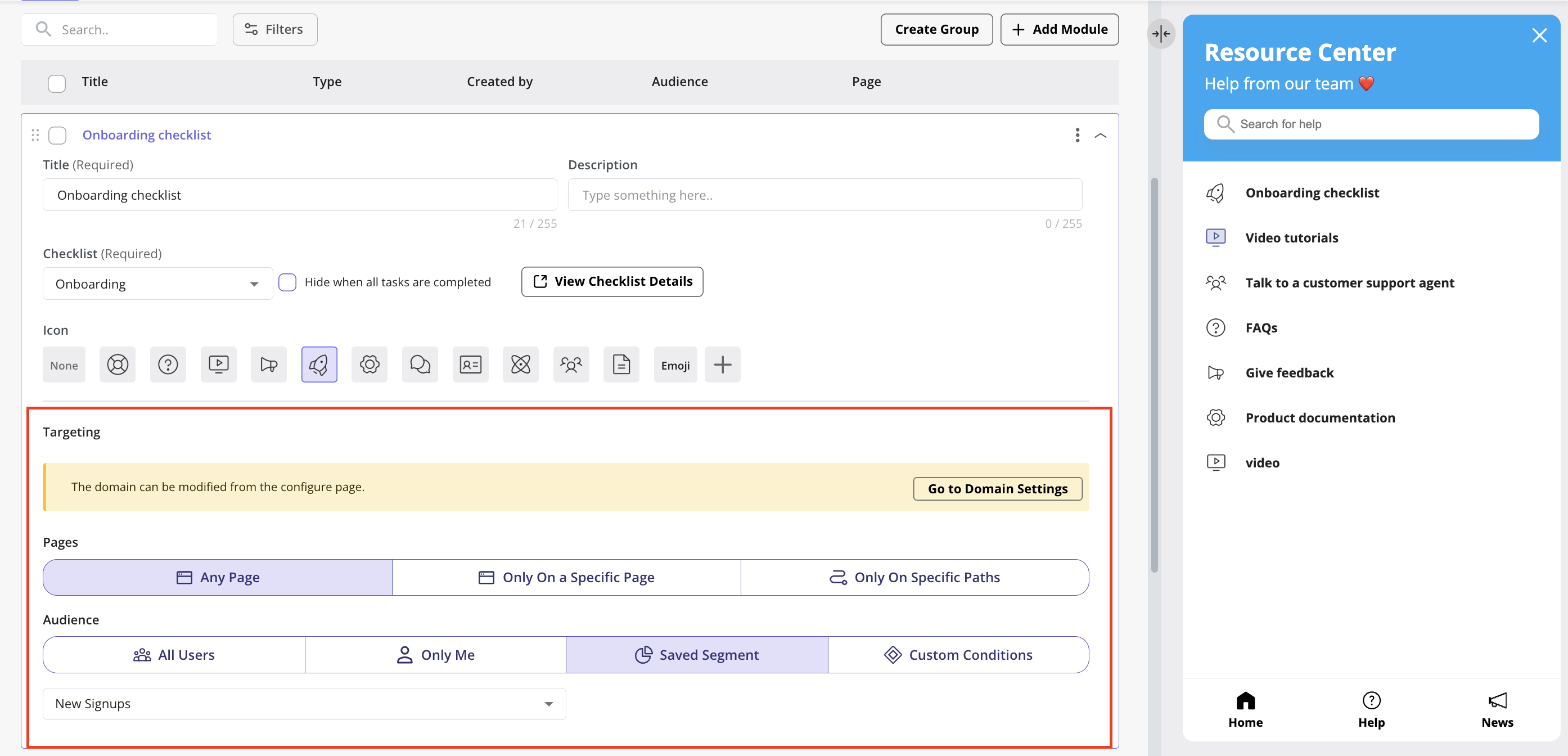
Help module visibility condition settings.
- Resource center analytics dashboard: The dedicated analytics dashboard helps you see how many unique visitors your resource center gets, how many modules have been clicked, the overall click rate across your user base, and popular search terms. This will make it easier to gauge resource center performance and identify if anything is missing from your resource center.

Resource center content analytics in Userpilot.
Pricing of Userpilot
Userpilot’s transparent pricing ranges from $249/month on the entry-level end to an Enterprise tier for larger companies.
Furthermore, Userpilot’s entry-level plan includes access to all UI patterns and should include everything that most mid-market SaaS businesses need to get started.

Userpilot has three paid plans to choose from:
- Starter: The entry-level Starter plan starts at $249/month and includes features like segmentation, product analytics, reporting, user engagement, NPS feedback, and customization.
- Growth: The Growth plan starts at $749/month and includes features like resource centers, advanced event-based triggers, unlimited feature tagging, AI-powered content localization, EU hosting options, and a dedicated customer success manager.
- Enterprise: The Enterprise plan uses custom pricing and includes all the features from Starter + Growth plus custom roles/permissions, access to premium integrations, priority support, custom contract, SLA, SAML SSO, activity logs, security audit, and compliance (SOC 2/GDPR).
Intercom vs HelpHero
There are many ways how HelpHero is different (and in a lot of ways better!) from Intercom. Let’s explore the features of HelpHero, how it’s better than Intercom, and how it may fall short too.
HelpHero for user onboarding
With HelpHero, you can create interactive, easy-to-follow product tours that help users get started and adopt new features quicker than ever.
Here’s a brief overview of HelpHero’s use case for user onboarding:
- User Onboarding Checklists: HelpHero’s checklists are a powerful tool that can help boost user onboarding. It lets you display a list of tasks for users to accomplish, making it even easier and quicker to onboard and engage new users to your app.
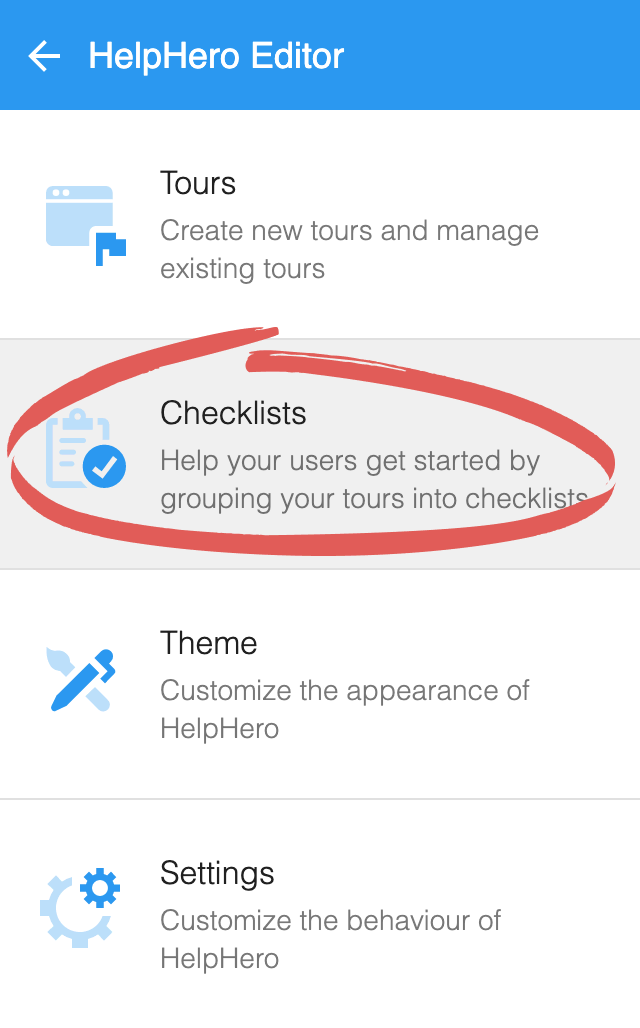
- Modals: HelpHero’s modals play a crucial role in product tours by providing interactive, contextual guidance. They enable users to ‘learn as they go’, directly within the product environment.
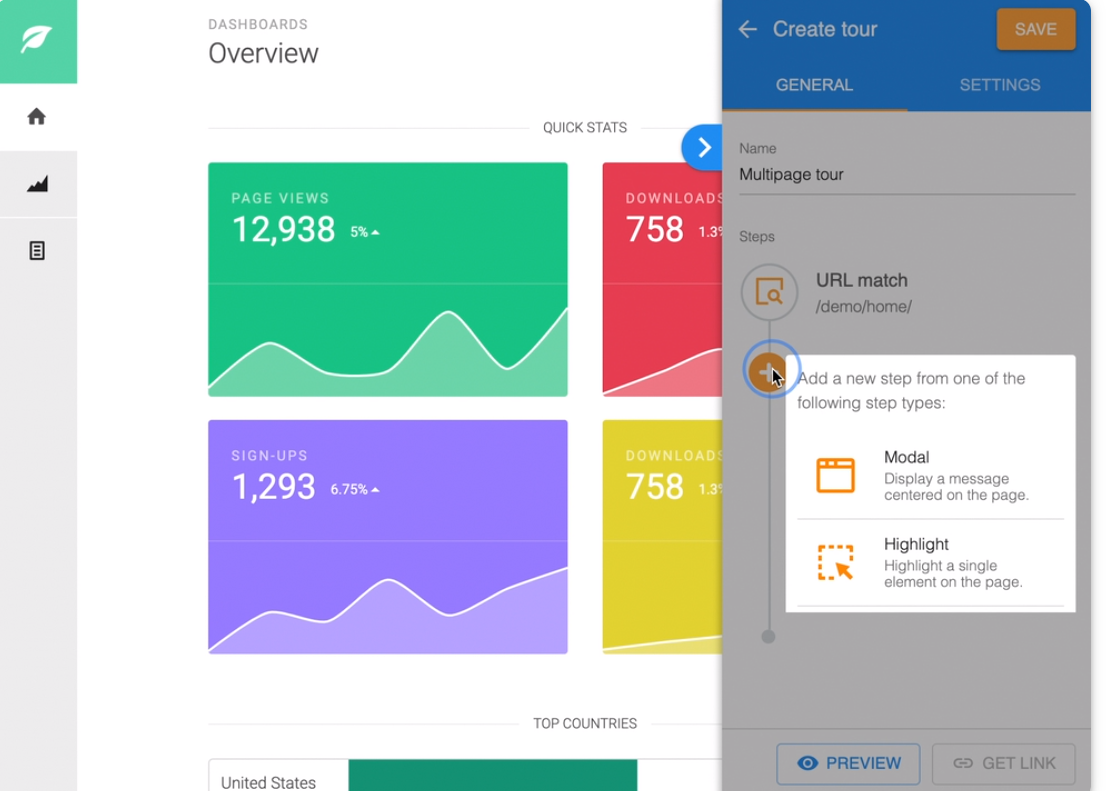
There are still other great features like multiple user onboarding UI patterns – on Userpilot, you can create tooltips, modals, slideouts, driven actions, banners, and hotspots. Each of them can be used individually or combined into a personalized onboarding experience.
Sign up for the Userpilot demo today.
HelpHero for product analytics
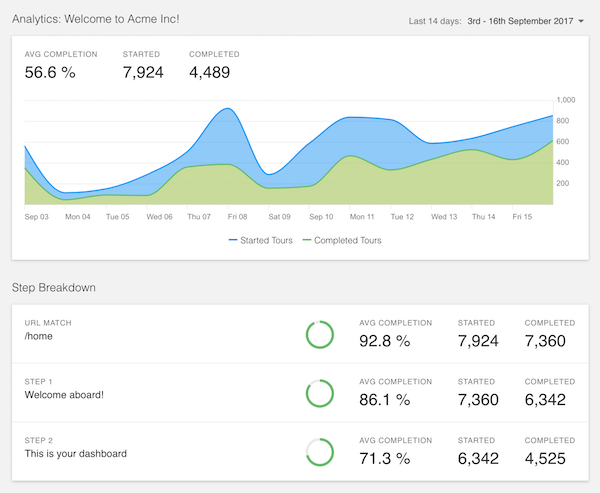
HelpHero’s analytics helps you understand how viewers are interacting with your tours, so you can identify opportunities for improving user experience.
- Automatic Tracking: HelpHero’s built-in analytics automatically track key metrics such as the number of tours started, tours completed, and the progress users make through the tours.
- Integration with External Analytics Tools: For those who prefer external analytics providers like Google Analytics or Mixpanel, HelpHero supports integration through its JavaScript API.
There are other important features like creating feature usage automatically. With Userpilot product analytics, you can make better decisions with actionable product analytics — understand user behavior across the product journey with powerful custom reports, and answer every product question. Try product analytics on Userpilot.
HelpHero for self-service support
Implementing a self-service approach will help you scale up without spending a fortune to maintain sufficient support quality.
Guided tours serve as a primer that introduces users to how a product works for the first time on HelpHero.

Outside of that, there are no self-help and knowledge repository integrations. Below is the little HelpHero offers in terms of self-service support:
- Interactive Walkthroughs: HelpHero allows the creation of step-by-step guides within the app, leading users through various functions and features. These walkthroughs can be customized and triggered based on user actions.
- Tooltips: It offers tooltip support, which provides contextual information when a user hovers over or clicks on specific elements in the app. This is useful for explaining buttons, features, or UI elements that take time to be intuitive.
- Hotspots: HelpHero enables the integration of hotspots within the app’s interface. These attention-grabbing indicators prompt users to explore or discover new features often used to highlight updates or underused aspects of the application.
However, HelpHero doesn’t provide an in-app resource center, necessary for self-service support. If you are looking for a better option to optimize your support, you should look into alternatives, such as Userpilot.
Pricing of HelpHero
HelpHero’s pricing plan is based on the number of Monthly Active Users (MAUs). Here’s an overview of the different pricing plans, including the free trial:

- HelpHero free trial: free 14-day trial, no credit card required.
- Up to 1000 MAU — $55
- Up to 2500 MAU — $115
- Up to 5000 MAU — $179
- Up to 10000 MAU — $249
- Up to 20000 MAU — $299
- If you have more than 20,000 Monthly Active Users, you have to contact them.
Intercom vs HelpScout
There are many ways how HelpScout is different (and in a lot of ways better!) from Intercom. Let’s explore the features of HelpScout, how it’s better than Intercom, and how it may fall short too.
HelpScout for user onboarding
A frictionless onboarding experience plays a crucial role in converting free trial users to paid ones. It can also help drive feature adoption and user retention.
Unlike Userpilot, Help Scout doesn’t offer tools to design targeted product tours or walkthroughs to handhold new users. Nevertheless, it comes with a few features that can support your onboarding efforts. These include:
- The Beacon tool lets you provide contextual support to new users. You can create a Beacon to recommend relevant knowledge base articles or encourage them to reach out to you via the live chat option. Additionally, you can customize the Beacon’s appearance to match your product’s branding.
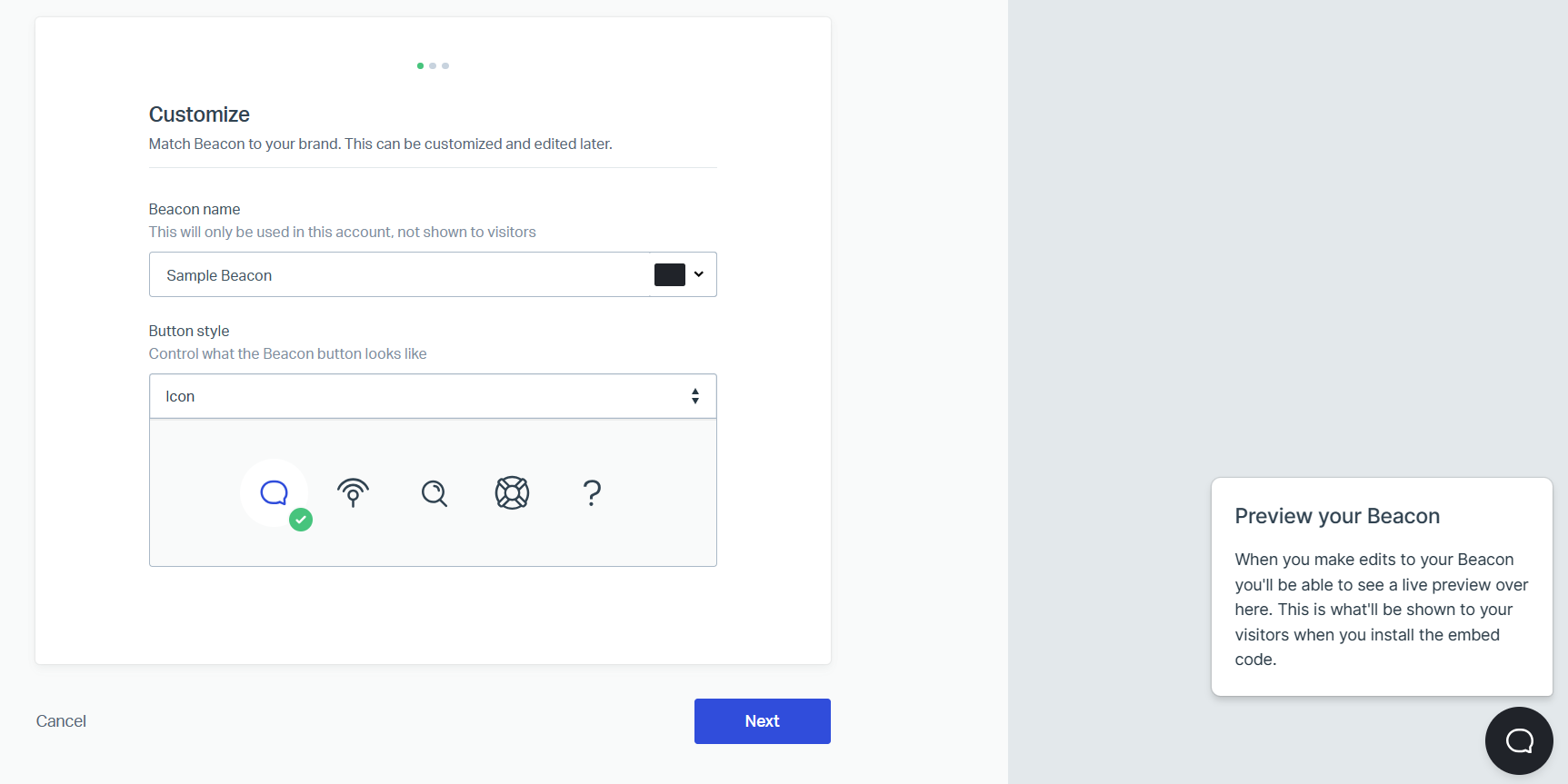
Beacon tool.
- If you’ve created a Beacon, you can use the Messages feature that lets you gently nudge users to check out product tours or setup guides. You can even send them important announcements regarding new features or upcoming outages. Timely updates can be crucial to minimizing friction in the user journey.

Messages in Beacon.
- The Docs features lets you build a robust knowledge base. You can create articles addressing common user queries or provide step-by-step instructions for different tools. You can even organize articles into different categories, making it easier for users to find relevant content.

Creating a knowledge base.
HelpScout for product analytics
Help Scout’s analytics and reporting features are restricted to customer support performance insights. The platform doesn’t offer any tools to track custom events or set up conversion funnels. That makes it difficult to assess metrics related to product adoption and growth. A dedicated digital adoption platform like Userpilot would be a better fit for product analytics.
HelpScout for self-service support
Whether you want to improve product activation or minimize churn rates, delivering a seamless user experience is non-negotiable. Self-service support plays a crucial role in this regard. It gives users the confidence to navigate your product and get the hang of different features.
Also, it minimizes the volume of support tickets and lets your customer service team focus on more pressing issues.
Here’s how you can implement self-service support with Help Scout:
- The Docs feature lets you build an extensive collection of knowledge-base articles. It can serve as a robust in-app resource center. You can group these articles into different categories, making it easier for users to find the information they need.
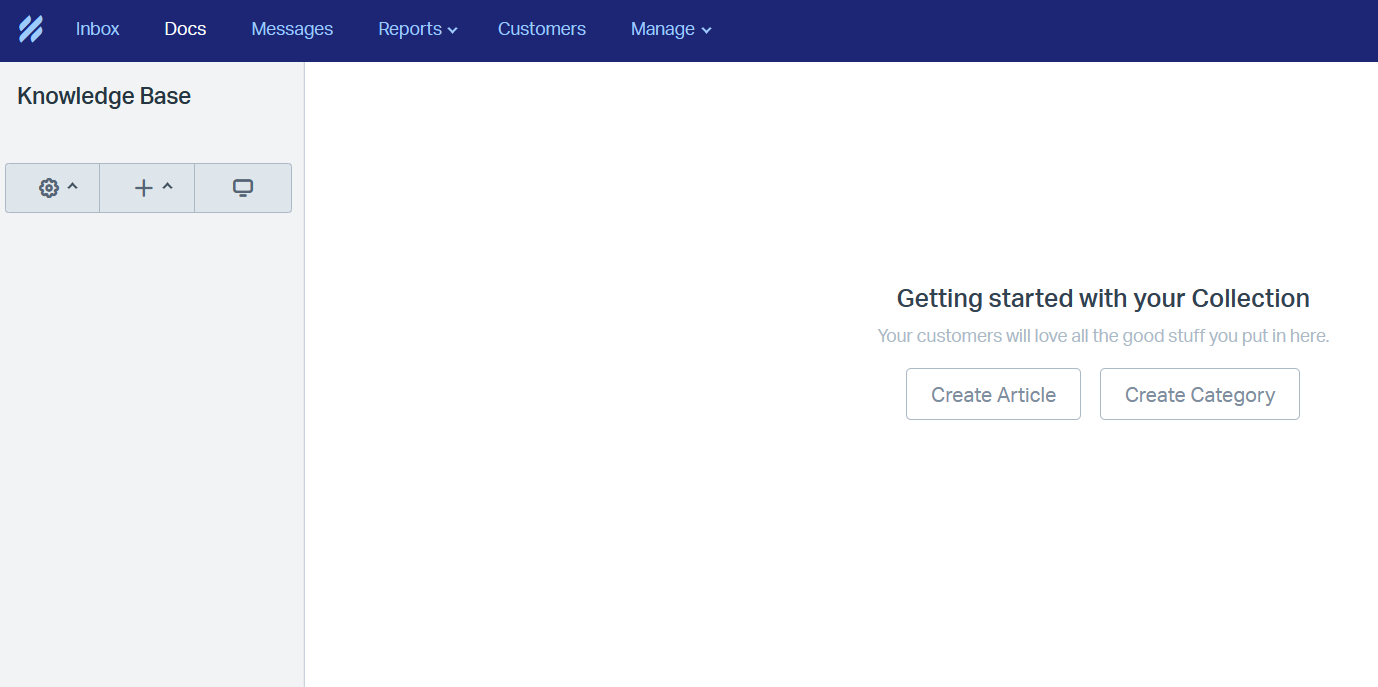
- However, keep in mind that you’ll have to create a separate file for each article and upload it to Help Scout. The platform doesn’t offer a built-in WYSIWYG editor to write, edit, and format text. If you’re looking for such a feature, Userpilot would be a better fit.
- Next, you can use the Beacon feature to recommend help center content to users. You can even send personalized recommendations based on where they are within your product or what actions they’ve taken on a page.
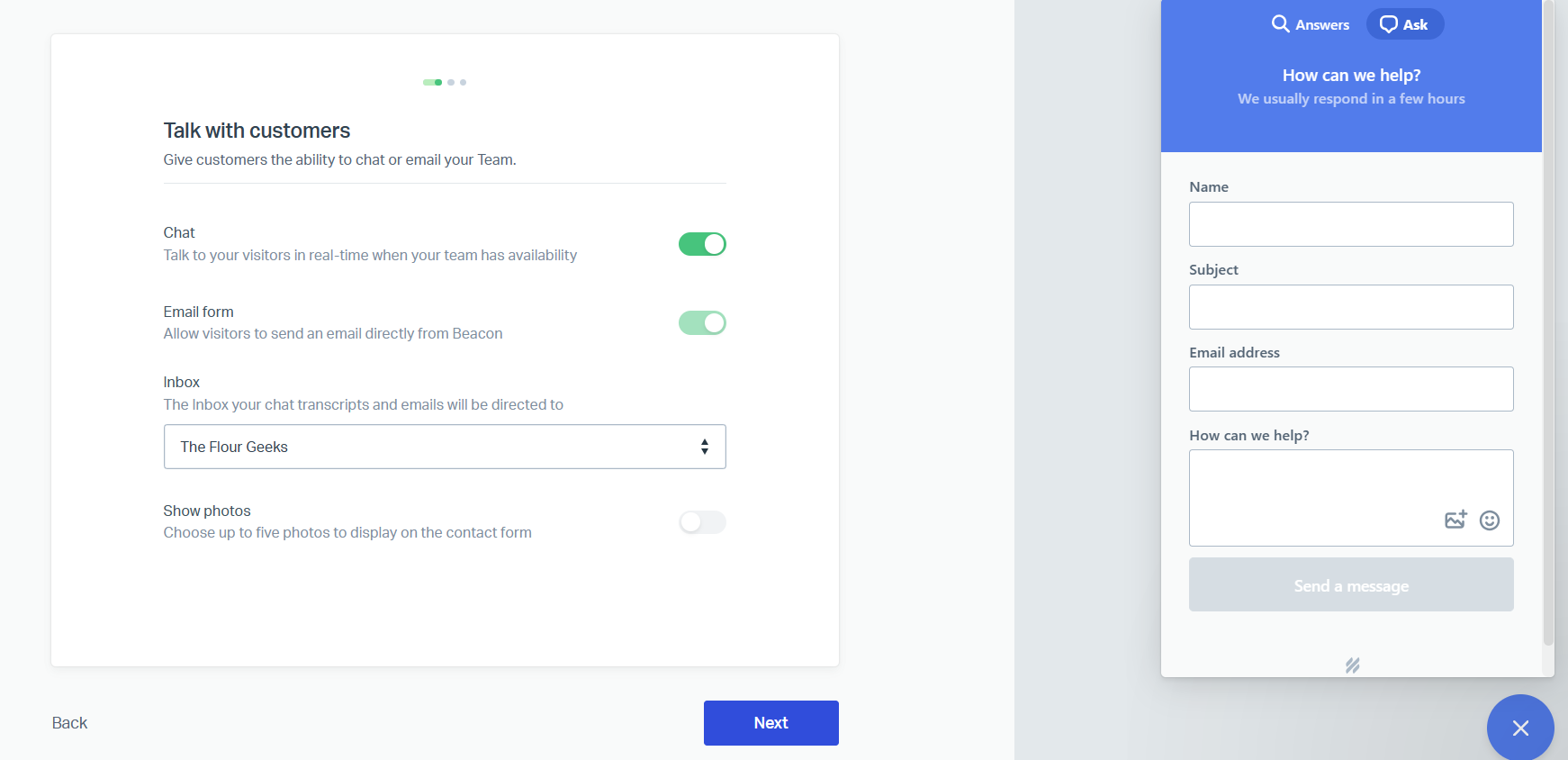
- With the Beacon tool, you can also recommend other in-app experiences, such as product tours and onboarding checklists, to users. For instance, you can nudge first-time visitors to check out a welcome tour of your product.
- Additionally, you can give users the option to contact customer support via live chat or email through a Beacon. It helps users seek assistance and troubleshoot problems in real time, which, in turn, minimizes friction.
Pricing of HelpScout
Help Scout offers three different pricing plans, with the total cost based on the number of users.
The plans include:
- Standard: It starts at $20 per user per month (billed annually) or $25 per user per month (billed monthly). It includes 2 shared inboxes and 1 Docs knowledge base. Also, you’ll have to pay extra for in-app messaging if the total number of viewers exceeds 2000.
- Plus: It starts at $40 per user per month (billed annually) or $50 per user per month (billed monthly). It includes everything in the Standard plan, along with advanced analytics, custom reporting, AI features, and integration with popular apps like Salesforce and HubSpot.
- Pro: It starts at $65 per user per month and only offers an annual subscription. It includes everything in the Plus plan, along with concierge onboarding services, a dedicated account manager, and enterprise-level security and compliance.
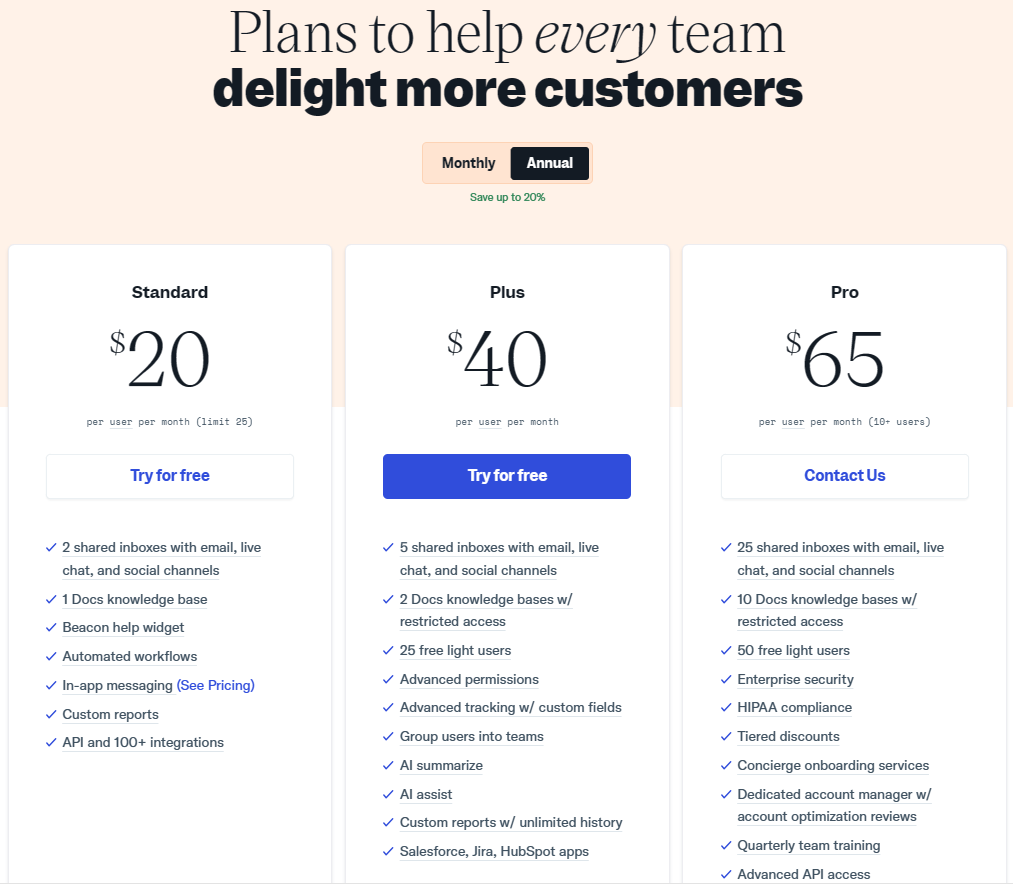
Pricing for Help Scout.
While the Standard plan is suitable for small teams with limited budgets, the Pro plan is a good fit for large businesses. However, keep in mind that pricing is based on the number of users, and the costs can quickly escalate as your team grows.
Help Scout offers a 15-day free trial that allows you to test various features and tools and determine whether it’s the right fit for your needs.
Intercom vs Whatfix
There are many ways in which Whatfix is different (and in a lot of ways better!) from Intercom. Let’s explore the features of Whatfix, how it’s better than Intercom, and how it may fall short too.
Whatfix for user onboarding
User onboarding is a complex process that only the most flexible tools can pull off. Whatfix has its fair share of bugs and technical quirks but there are a few features that bolster its onboarding capabilities — namely its tours, checklists, and integrations.
Here’s an overview of Whatfix’s onboarding features:
- Whatfix lets you create interactive product tours for both users and employees. This reduces the time to value (TTV), whether it’s for customers using your product or employees learning how to use a solution in the internal tool stack.
- Onboarding checklists (known as task lists on Whatfix) give new users or employees a clear next step on their journey toward product adoption. Whatfix lets you create these checklists as widgets target specific segments, and group tasks under headers.
- Whatfix’s gallery of direct integrations with tools like Salesforce, Amplitude, SurveyMonkey, and more helps you centralize all onboarding data. The onboarding metrics gathered and synced across tools can then help you streamline your in-app flows.
Whatfix for product analytics
Whatfix has a separate product analytics solution that is billed separately from its mainline digital adoption platform (but has no pricing listed on the website).
Here’s an overview of Whatfix’s product analytics capabilities:
- Whatfix has both trend and funnel report types available which can help you see how your customers or employees use different software applications. This will show you which paths users take, which elements they interact with, and what browser/OS they use to do so.
- Track user properties like the type of device they’re on, which browser they’re using, or where they’re from. Unfortunately, this data isn’t available for desktop-based applications.
- Limitations: Whatfix analytics lacks clarity and scalability (especially on the entry-level plan). Those on the Standard plan can only tag 25 actions and there’s no indication of how much it will cost to lift that limit by upgrading.
Whatfix for self-service support
Providing self-service options for employees and customers is crucial for multiple reasons. Mainly, it speeds up the product adoption process while simultaneously reducing the workload for your support team. Whatfix lets you offer multiple types of self-service support.
Here’s an overview of Whatfix’s self-service support functionality:
- In-App Guidance: Whatfix’s in-app guidance features can be used to show customers or employees how to use a particular application. These flows could go over specific processes, highlight individual features, or serve as a walkthrough for the overall onboarding sequence.
- Contextual Help: You can use Whatfix to provide contextual support to users when they need it most, so they don’t need to take up your team’s time by submitting tickets. These self-help resources make the answer to common queries easily accessible from anywhere on the web.
- Multi-Channel Support: Whatfix gives you the ability to provide technical support throughout every touchpoint your organization uses. This includes email, chat, social media, support platforms, or other channels that the company utilizes to assist users.
Pricing of Whatfix
Whatfix doesn’t have public pricing listed on its website. It also charges separately for its product analytics solution but we won’t be going over those plans since we’re focusing on the digital adoption platform.
Here’s an overview of the three plans available for Whatfix web:
- Standard: This includes core features like in-app guidance, contextual guidance, a multi-media knowledge base, and content aggregation capabilities. It also includes access to pre-built surveys and up to two integrations.
- Premium: This includes additional features such as automatic content localization, automated flow testing, unlimited integrations, and single sign-on (SSO). You’ll also be able to build custom surveys while on the Premium plan.
- Pro: This includes the features from previous plans as well as enterprise-exclusive options such as self-hosting. This plan is targeted towards customer-facing applications with a million or more users.
Conclusion
As you can see, there are many different competitors and alternatives to Intercom. We’ve discussed a few above – but which one is the best?
The answer is “it depends” – but we strongly believe that if you’re a mid-market SaaS company looking for a great user onboarding and product analytics tool, Userpilot is the best option for you.
Hopefully, you found this post helpful. And if you need any help with how Userpilot is different, schedule a demo to get started!


